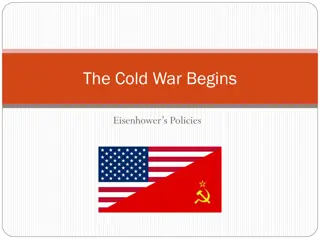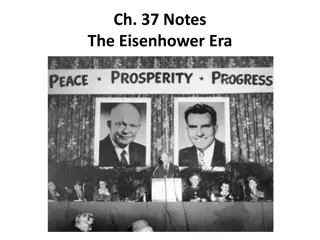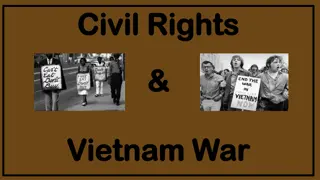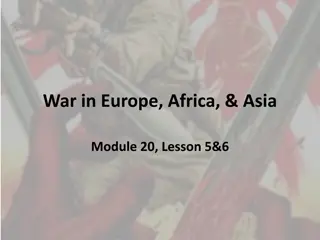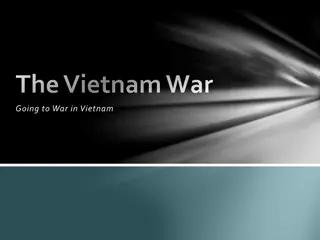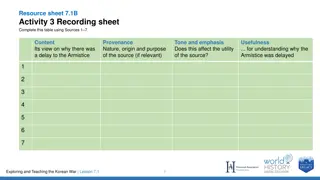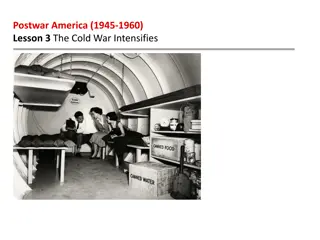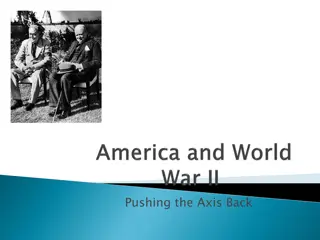Eisenhower Matrix for Efficient Task Prioritization
Use the Eisenhower Matrix template to effectively prioritize project tasks by distinguishing between urgent and important activities. Delegate, delete, or tackle tasks based on their significance for optimal time management. An example matrix provided showcases various tasks categorized as urgent/im
1 views • 4 slides
The Cold War Begins: Eisenhower's Policies and Achievements
President Dwight D. Eisenhower's era marked by the concept of massive retaliation, the space race, brinksmanship strategies, and efforts to combat communism. Eisenhower's leadership during the Sputnik Crisis and Korean War showcased his commitment to containing communism and advancing U.S. interests
6 views • 16 slides
The Transformation of American Society: A Shift to Suburbs and Service Sector Dominance
The period from 1940 to 1960 witnessed a significant societal transformation in America. More than 40 million Americans moved to the suburbs, facilitated by affordable housing initiatives like William Levitt's mass production. The rise of the car culture and the construction of the Eisenhower Inters
4 views • 15 slides
Insights into the Eisenhower Era and Dynamic Conservatism
The content delves into key events during the Eisenhower era, including the Election of 1952, Nixon's Checkers Speech, Eisenhower's dynamic conservatism, the Federal Highway Act of 1956, and the impact of the highway system on American culture. It highlights Eisenhower's leadership style, the changi
4 views • 31 slides
Eisenhower's Cold War Policies and Covert Operations
Eisenhower's Cold War policies focused on Massive Retaliation, Brinkmanship, and Covert Operations. He believed in investing in nuclear weapons and used threats of nuclear capabilities to deter conflicts. The CIA carried out covert operations to overthrow anti-American leaders in different countries
0 views • 10 slides
The Impact of Civil Rights Movement and President Eisenhower's Legacy
Explore the significant events like the Civil Rights Movement, the popular presidency of Dwight D. Eisenhower, the Federal Aid Highway Act of 1956, the Baby Boom Years, and the advent of television in the lives of Americans during the mid-20th century. Learn about civil rights, segregation, the Brow
3 views • 24 slides
World War II Campaigns in Europe, Africa, and Asia
The module discusses various campaigns during World War II in different regions such as the Atlantic, Eastern Front, North Africa, Italy, Western Front, and Pacific. It highlights significant battles like the Battle of Stalingrad in 1942, the strategic decisions made by leaders like Stalin, FDR, and
0 views • 18 slides
The Evolution of Veterans Day: From Armistice to Honoring American Veterans
Reflecting on the history and transformation of Veterans Day, from its origins as Armistice Day in 1919 to honoring American veterans of all wars. President Eisenhower's role in changing the day and its significance in commemorating the heroism and sacrifice of those who served. Recognized by Congre
2 views • 9 slides
The Cold War Expansion and Nuclear Arms Race
The Cold War intensified as the Soviet Union detonated an atomic bomb, leading to heightened tensions. Communist advancements, including the takeover of communist China, shocked the world. Nuclear arsenals expanded with the development of the hydrogen bomb, sparking concerns of an arms race. Eisenho
0 views • 17 slides
The Vietnam War: American Involvement and Escalation
The Vietnam War saw deepening American involvement, from military advisors under Eisenhower to troop deployments and sustained bombing campaigns under Kennedy and Johnson. The conflict escalated with political turmoil in Vietnam, the Gulf of Tonkin Resolution, and the emergence of a bloody stalemate
0 views • 10 slides
Understanding Delay in the Korean Armistice Negotiations
Sources 1 to 4 provide insights into the reasons behind the delay in reaching an armistice during the Korean War. Source 1 discusses the POW question's impact, Source 2 presents Eisenhower's stance on peace efforts, Source 3 outlines Syngmam Rhee's opposition to a divided Korea, and Source 4 reflect
0 views • 9 slides
Exploring Leadership Qualities and Characteristics
Delve into the essence of leadership through definitions, visual representations, and insights from notable figures. Reflect on the traits essential for effective leadership, drawing inspiration from icons like Dwight D. Eisenhower. Analyze character descriptions and engage in thoughtful discussions
0 views • 15 slides
The Cold War Escalates: Postwar America 1945-1960 Lesson 3
The period after World War II saw tensions intensify between the United States and the Soviet Union, leading to a global struggle for influence. The arms race, the space race, and significant international conflicts all heightened Cold War tensions. President Eisenhower's response to communism diffe
0 views • 17 slides
Efficient Work Management with Scrum Methodology
Learn how to effectively organize and expedite your work using Scrum, a project management process. Discover the principles of Scrum, prioritize tasks, create backlogs, and utilize techniques like the Eisenhower Matrix to enhance productivity and achieve success in your projects.
0 views • 20 slides
Allied Operations in World War II Leading to the Normandy Invasion
During World War II, strategic operations such as pushing Axis forces back in Italy, the Casablanca Conference decisions, and planning for the Normandy invasion played crucial roles in the eventual Allied victory. Key events included capturing Sicily, the arrest of Mussolini, agreements between worl
0 views • 8 slides

